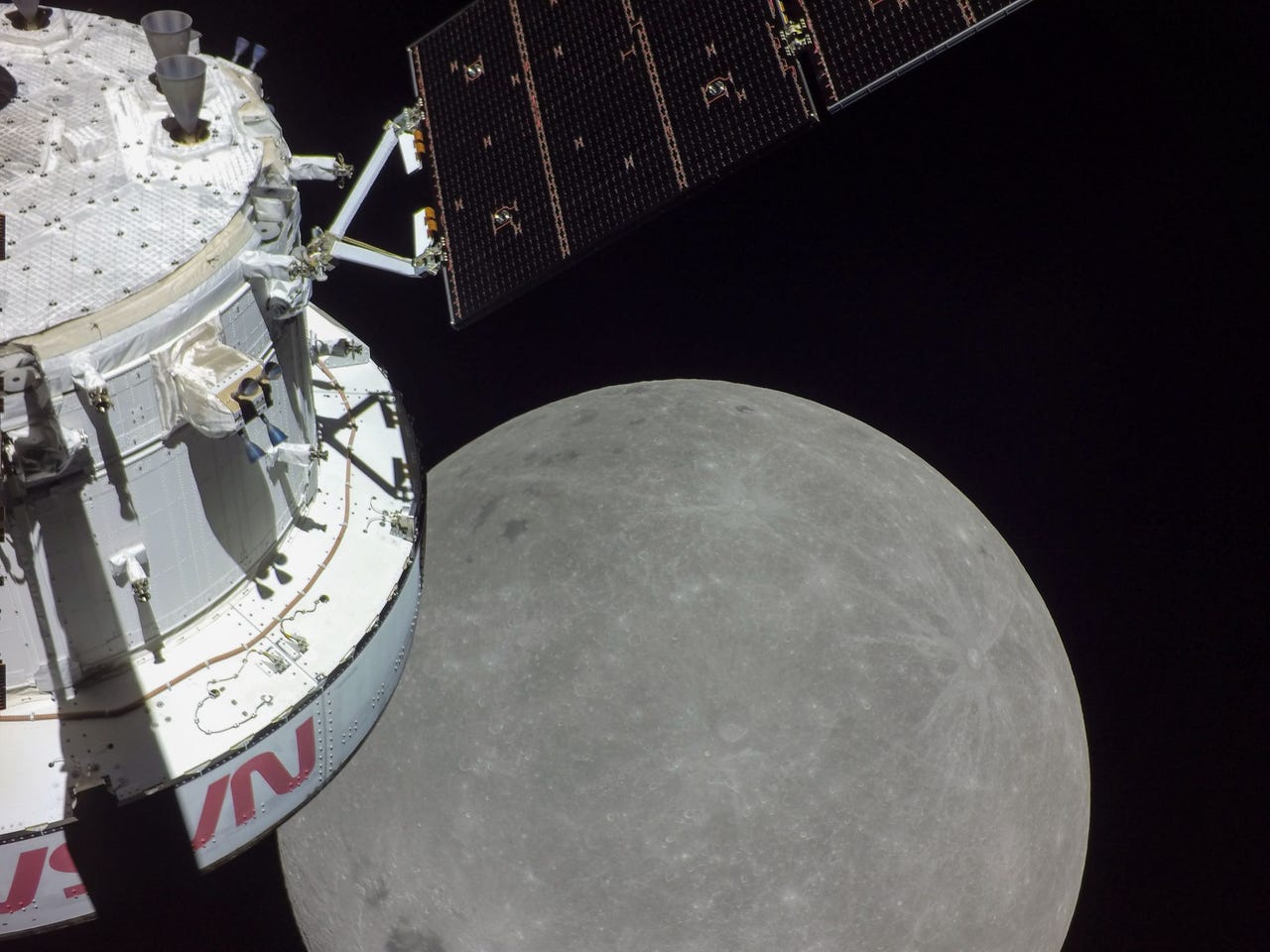
































A portion of the far side of the Moon looms large just beyond the Orion spacecraft.
Image: NASANASA mission control center's comms link with the Artemis I Orion spacecraft suffered a nearly hour-long outage during its journey to a "distant retrograde orbit" around the Moon.
Mission control in Houston lost data to and from Orion at 12:09 am CST for 47 minutes while engineers were reconfiguring the communication link between the spacecraft and Deep Space Network.
Engineers are now conducting a root cause analysis to understand why signals unexpectedly failed despite having tested the procedure several times during the past week.
"This is why we test," said Jim Free, NASA's associate administrator for exploration systems development, after the link was restored.
This is why we test. Overnight, we unexpectedly lost communication with @NASA_Orion while reconfiguring the link between the spacecraft and the Deep Space Network. We've since restored the link with an adjustment on the ground and are examining root cause. https://t.co/F4hzPfZ4Ra pic.twitter.com/JexapC2i0E
- Jim Free (@JimFree) November 23, 2022
The data has not been lost as it was recorded on Orion's onboard systems. The Command and Data Handling Officer (C&DH) -the office that will handle Orion's display interfaces for future crewed Artemis II missions -will downlink the data recorded during the outage as part of its analysis.
"There was no impact to Orion, and the spacecraft remains in a healthy configuration," NASA said in an update.
Distant retrograde orbit (DRO) optimizes Orion's fuel stores and is where the spacecraft will remain stable for the next few weeks. Objects in DRO are balanced between the gravitational pull of Earth and the Moon. The "retrograde" part refers to Orion traveling in the opposite direction to Moon's orbit of Earth.
Also:What is Artemis? Everything you need to know about NASA's new moon mission
NASA needs to conserve Orion's fuel for correction and propulsion burns for its flyby past the Moon again and journey back to Earth when it will splashdown in the Pacific Ocean around December 8.
NASA plans for Orion to depart DRO on December 1, after which it will commence a powered flyby of the Moon on December 5.
"The spacecraft will reach its farthest distance from the Moon Friday, Nov 25, just before performing the next major burn to enter the orbit," NASA said in an update on Wednesday.
"The distant retrograde orbit insertion burn is the second in a pair of maneuvers required to propel Orion into the highly stable orbit that requires minimal fuel consumption while traveling around the Moon," it explained.
Another interesting test NASA is conducting as Orion moves towards DRO is the "prop splosh" test, or testing the effect the propellant sloshing has on Orion's trajectory and orientation while it moves through space. The tests happen after each Moon flyby burns -both outbound and return. This allows engineers to compare data when the space craft is carrying different volumes of the liquid propellant, which is difficult to model on Earth due to differences in gravity.
To make the liquid slosh, NASA will use Orion's reaction control thrusters, which are located on the sides of the service module, and can be turned on and off to move the spacecraft and slosh the propellant.
"These engines are in fixed positions and can be fired individually as needed to move the spacecraft in different directions or rotate it into any position. Each engine provides about 50 pounds of thrust," NASA explains.
On Monday, November 21, after Orion's outbound flyby of the Moon, it had used 3,715.7 pounds of propellant. NASA says, as Wednesday, November 23, Orion had used about 3,971 pounds of propellant.
"There is more than 2,000 pounds of margin available over what is planned for use during the mission, an increase of about 74 pounds from prelaunch expected values," NASA notes, suggesting the spacecraft and manoeuvres so far have been more efficient than modelled for.
Also: After the Moon flyby, what's next for NASA's Artemis I Orion spacecraft?
Separately, the Artemis I Space Launch System (SLS) rocket deployed 10 small CubeSats within Orion last week. One of them, BioSentinel, completed its lunar flyby on Tuesday. It's being used to study the impacts of space radiation on yeast -one of Orion's "biological passengers".
The idea is to test biological matter in preparation of human travel on "increasingly farther and longer-duration missions to destinations like Mars", according to Mars. NASA is testing two strains of yeast in deep space because yeast shares similarities with human cells and it wants to find out how human cells are affected by long-term exposure to radiation in deep space.
"Often, DNA damage can be repaired by cells in a process that is very similar between yeast and humans," NASA notes.
One strain of yeast being tested in space is natural. The other was selected because it has trouble repairing its DNA.
"By comparing how the two strains respond to the deep space radiation environment, researchers will learn more about the health risks posed to humans during long-term exploration and be able to develop informed strategies for reducing potential damage," says NASA.
#ICYMI: BioSentinel completed a lunar flyby on Nov. 22!
- NASA Ames (@NASAAmes) November 23, 2022
The spacecraft flew in darkness for 36 minutes as it was eclipsed by the Moon. Now it is once again pointing its solar panels at the Sun and recharging its batteries. Learn more: https://t.co/yXr6DXIy7C pic.twitter.com/bBVoPRfnOX
 Горячие метки:
3. Инновации
1. Космос
Горячие метки:
3. Инновации
1. Космос